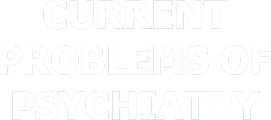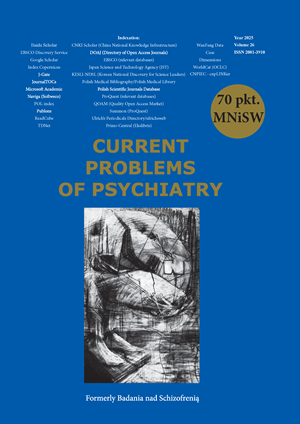Zespół eksplodującej głowy – zagadkowa parasomnia: przegląd literatury
DOI:
https://doi.org/10.12923/2353-8627/2025-0008Słowa kluczowe:
zespół eksplodującej głowy, parasomnie, zaburzenia snuAbstrakt
Wprowadzenie: Zespół eksplodującej głowy (exploding head syndrome, EHS) to rzadko diagnozowane zaburzenie snu zaliczane do parasomnii. Charakteryzuje się nagłymi halucynacjami słuchowymi, przypominającymi eksplozje, strzały lub głośne trzaski, które występują podczas zasypiania lub wybudzania się ze snu. Choć EHS zwykle nie powoduje fizycznego bólu, często wiąże się z silnym lękiem i zakłóceniem snu. Pomimo stosunkowo wysokiej częstości występowania, świadomość tego zaburzenia wśród lekarzy i pacjentów jest niewielka.
Cel i metody: Celem artykułu jest przedstawienie aktualnego stanu wiedzy na temat EHS, jego klasyfikacji, symptomatologii, diagnozy oraz metod leczenia. Dokonano przeglądu literatury w bazach PubMed i Google Scholar, obejmując publikacje z lat 1980–2025, wyszukując hasła: exploding head syndrome, parasomnias, sleep disorders.
Wyniki: Częstość występowania EHS nie została jednoznacznie sprecyzowana, wyniki badań wskazują, że może on dotyczyć od 10–52,7% populacji. Pomimo, że pierwsze opisy tego zaburzenia sięgają XVII wieku to Klasyfikacja ICD, pierwszy raz uwzględniła ten zespół wraz z kryteriami jego rozpoznania w ostatniej 11 edycji. Zespół ten może współwystępować z innymi zaburzeniami snu, neurologicznymi i zaburzeniami psychicznymi. Etiologia pozostaje niejasna, ale najpopularniejsze teorie sugerują, że może być związana z nieprawidłową aktywnością pnia mózgu lub zaburzeniami neurotransmisji GABAergicznej, serotoninergicznej czy też dysfunkcjami w zakresie przetwarzania sensorycznego. Leczenie opiera się głównie na psychoedukacji, poprawie higieny snu oraz w niektórych przypadkach farmakoterapii.
Wnioski: EHS jest niedostatecznie rozpoznawanym zaburzeniem, wymagającym dalszych badań. Wzrost świadomości i lepsza diagnostyka mogą poprawić jakość życia pacjentów. Potrzebne są dalsze badania nad jego mechanizmami i skutecznymi metodami leczenia.
Bibliografia
1. Singh S, Kaur H, Singh S, Khawaja I. Parasomnias: A Comprehensive Review. Cureus.2018;10:12.
2. American Academy of Sleep Medicine. ICSD-3 Online Version -American Academy of Sleep Medicine (AASM). AASM 2014.
3. Pirzada AR, Almeneessier AS, Bahammam AS. Exploding Head Syndrome: A Case Series of Underdiagnosed HypnicParasomnia. Case Rep Neurol. 2020;12(3): 348-358.
4. Sharpless BA. Exploding head syndrome. Sleep Med Rev. 2014;18:489-93.
5. Fortune DG, Richards HL. Exploding Head Syndrome: A Systematic Scoping Review. Sleep Med Clin. 2024;19:121-42.
6. Ceriani CEJ, Nahas SJ. Exploding Head Syndrome: a Review. Curr Pain Headache Rep. 2018;22.
7. Kaneko Y, Kawae A, Saitoh K, Gon Y, Uchiyama M, Suzuki M. Exploding Head Syndrome Accompanied by Repeating Panic Attacks: A Case Report. . Front Psychiatry. 2021;11: 613420.
8. Cohen AS, Kaube H. Rare nocturnal headaches. CurrOpin Neurol. 2004;17(3): 295-299.
9. Casucci G, D’Onofrio F, Torelli P. Rare primary headaches: Clinical insights. Neurological Sciences. 2004;25:77-83.
10. Queiroz LP. Unusual headache syndromes. Headache. 2013;53(1): 12-22.
11. Jacome DE. Exploding head syndrome and idiopathic stabbing headache relieved by nifedipine. Cephalalgia. 2001;21(5): 617-618.
12. Sharpless BA. Characteristic symptoms and associated features of exploding head syndrome in undergraduates. Cephalalgia 2018;38.
13. Icd.who.int.ICD-11 for Mortality and Morbidity Statistics. Dostępna z: https://icd.who.int/browse/2025-01/mms/ en#1393951214
14. Otaiku AI. Did René Descartes have exploding head syndrome? J. Clin. Sleep Med. 2018;14(4): 675-678.
15. Mitchell SW. SOME DISORDERS OF SLEEP. Am J Med Sci 1890;100.
16. Pearce JMS. Clinical features of the exploding head syndrome. J NeurolNeurosurg Psychiatry. 1989; 52(7): 907-910.
17. Goadsby PJ, Sharpless BA. Exploding head syndrome, snapping of the brain or episodic cranial sensory shock? J NeurolNeurosurg Psychiatry.2016; 87(11): 1259-1260.
18. Galecki P., Pilecki M., Rymaszewska J., Szulc A., Sidorowicz S. WJ. Kryteria diagnostyczne zaburzeń psychicznych DSM-5. vol. 43. 2014.
19. American PsychiatricAssociation, ed. Diagnostic and Statistical Manual of Mental Disorders, Fifth Edition, Text Revision (DSM-5-TR). Washington, DC, USA: American Psychiatric Publishing.2022; ISBN 978-0-89042-575-6.
20. Ganguly G, Mridha B, Khan A, Rison RA. Exploding head syndrome: A case report. Case Rep Neurol. 2013;5(1), 14-17.
21. Salih F, Klingebiel R, Zschenderlein R, Grosse P. Acoustic sleep starts with sleep-onset insomnia related to a brainstem lesion. Neurology. 2008;70(20), 1935-1937.
22. Frese A, Summ O, Evers S. Exploding head syndrome: Six new cases and review of the literature. Cephalalgia. 2014;34(10): 823-827.
23. Wang X, Zhang W, Yuan N, Zhang Y, Liu Y. Characteristic symptoms of exploding head syndrome in two male patients. Sleep Med. 2019; 57: 94-96.
24. Sachs C, Svanborg E. The exploding head syndrome: Polysomnographic recordings and therapeutic suggestions. Sleep. 1991;14(3): 263-266.
25. Palikh GM, Vaughn B V. Topiramate responsive exploding head syndrome. J. Clin. Sleep Med. 2010;6(4): 382-383.
26. Evans RW, Pearce JMS. Exploding head syndrome. Headache 2001;41.
27. Chakravarty A. Exploding head syndrome: Report of two new cases. Cephalalgia. 2008;28(4): 399-400.
28. Denis D, Poerio GL, Derveeuw S, Badini I, Gregory AM. Associations between exploding head syndrome and measures of sleep quality and experiences, dissociation, and well-being. Sleep Med. 2023;104:105-112.
29. Sharpless BA. Exploding head syndrome is common in college students. J Sleep Res. 2015; 24(4): 447-449.
30. Fulda S, Hornyak M, Müller K, Cerny L, Beitinger PA, Wetter TC. Development and validation of the Munich Parasomnia Screening (MUPS). Somnologie -Schlafforschung Und Schlafmedizin 2008;12.
31. Sharpless BA, Denis D, Perach R, French CC, Gregory AM. Exploding head syndrome: clinical features, theories about etiology, and prevention strategies in a large international sample. Sleep Med. 2020;75: 251-255.
32. Kirwan E, Fortune DG. Exploding head syndrome, chronotype, parasomnias and mental health in young adults. J Sleep Res 2021;30.
33. Sherwood SJ. Relationship between childhood hypnagogic, hypnopompic, and sleep experiences, childhood fantasy proneness, and anomalous experiences and beliefs: An exploratory WWW survey. Journal Of The American Society For Psychical Research 1999;93.
34. Ji KH. Exploding Head Syndrome Associated With Severe Obstructive Sleep Apnea. Sleep Med Res. 2022;13(3): 176-178.
35. Nakayama M, Nakano N, Mihara T, Arima S, Sato S, Kabaya K, et al. Two cases of exploding head syndrome documented by polysomnography that improved after treatment. J Clin. Sleep Med. 2021;17(1):103-106.
36. Swingle N, Davis EM, Quigg M. Exploding Head Syndrome Associated with Central Hypoventilatory Hypopnea. Ann Am Thorac Soc. 2023; 20(7): 1061-1065.
37. Sumi Y, Miyamoto T, Sudo S, Kadotani H, Ozeki Y, Imai M. Explosive sound without external stimuli following electroencephalography kappa rhythm fluctuation: A case report. Cephalalgia. 2021;(13): 1396-1401.
38. Aazh H, Stevens J, Jacquemin L. Exploding Head Syndrome among patients seeking help for tinnitus and/or hyperacusis at an Audiology Department in the UK: A preliminary study. J Am AcadAudiol. 2023; 57: 94-96.
39. Alkhateeb W, Krishnaraj A, Saini V. Single Patient Multiple Explosions: A Case Report on Exploding Head Syndrome. Cureus. 2023;15 (8).
40. Tsovoosed U, Sumi Y, Ozeki Y, Harada A, Kadotani H. Prevalence and impact of exploding head syndrome in a Japanese working population. Sleep 2025;7.
41. Rauf B, Sharpless BA, Denis D, Perach R, Madrid-Valero JJ, French CC, et al. Isolated sleep paralysis: Clinical features, perception of aetiology, prevention and disruption strategies in a large international sample. Sleep Med. 2023;104:105-112.
42. Feketeova E, Buskova J, Skorvanek M, Mudra J, Gdovinova Z. Exploding head syndrome -a rare parasomnia or a dissociative episode? Sleep Med. 2014; 15(6): 728-730.
43. Gillis K, Ng MC. Exploding Head Syndrome in the Epilepsy Monitoring Unit: Case Report and Literature Review. NeurodiagnJ.2017;57(2): 133-138.
44. Kallweit U, Khatami R, Bassetti CL. Exploding head syndrome -More than “snapping of the brain”? Sleep Med 2008;9.
45. Yoon J-E, Hwang KJ, Roh T-H, Shin WC. A Case of Exploding Head Syndrome: Focus on Polysomnographic Finding. J. Korean Sleep Res. Soc. 2011; 8(2): 45-47.
46. Vyazovskiy V V., Olcese U, Hanlon EC, Nir Y, Cirelli C, Tononi G. Local sleep in awake rats. Nature. 2011;472(7344): 443-447.
47. FotisSakellariou D, Nesbitt AD, Higgins S, Beniczky S, Rosenzweig J, Drakatos P, et al. Co-activation of rhythms during alpha band oscillations as an interictal biomarker of exploding head syndrome. Cephalalgia. 2020;40(9): 949-958.
48. Sharpless BA. A clinician’s guide to recurrent isolated sleep paralysis. Neuropsychiatr Dis Treat. 2016;12:1761-7.
49. Kitagawa S, Okamoto N, Ikenouchi A, Igata R, Hashimoto R, Konishi Y, et al. A case of exploding head syndrome preceding the onset of mild cognitive impairment with Lewy bodies. Psychogeriatrics. 2023;23:2.
50. Gardiner C, Weakley J, Burke LM, Roach GD, Sargent C, Maniar N, et al. The effect of alcohol on subsequent sleep in healthy adults: A systematic review and meta-analysis. Sleep Med Rev. 2025;80:102030.
51. Koob GF, Colrain IM. Alcohol use disorder and sleep disturbances: a feed-forward allostatic framework. Neuropsychopharmacology. 2020;45.
52. Burgos-Sanchez C, Jones NN, Avillion M, Gibson SJ, Patel JA, Neighbors J, et al. Impact of Alcohol Consumption on Snoring and Sleep Apnea: A Systematic Review and Meta-analysis. Otolaryngology - Head and Neck Surgery.163(6), 1078-1086.
53. Puledda F, Moreno-Ajona D, Goadsby PJ. Exploding head syndrome (a.k.a. episodic cranial sensory shock) responds to single-pulse transcranial magnetic stimulation. Eur J Neurol. 2021;28(4): 1432-1433.
Pobrania
Opublikowane
Numer
Dział
Licencja
Prawa autorskie (c) 2025 Paulina Wróbel-Knybel, Klaudia Kister (Autor)

Utwór dostępny jest na licencji Creative Commons Uznanie autorstwa 4.0 Międzynarodowe.


